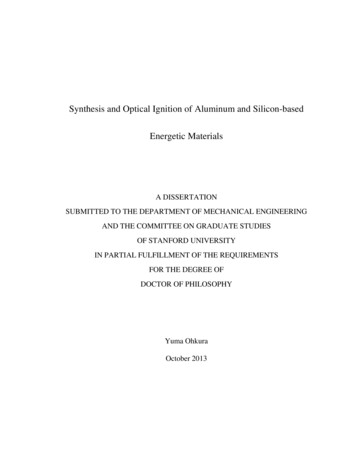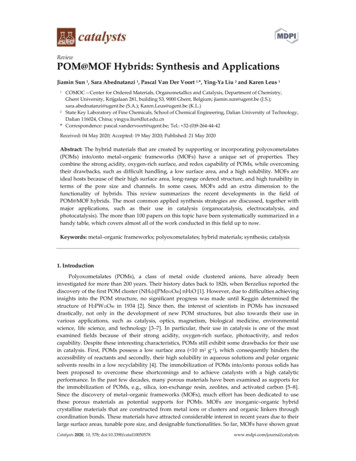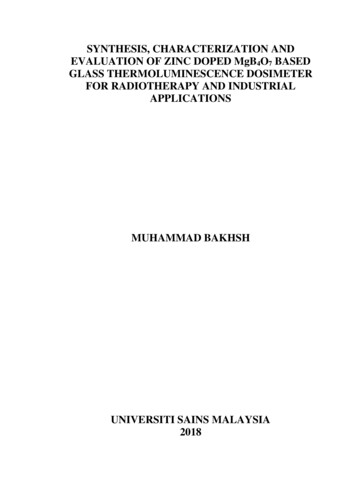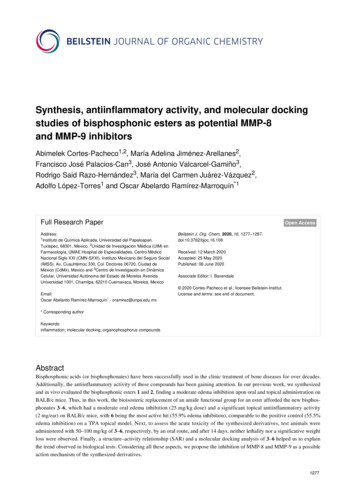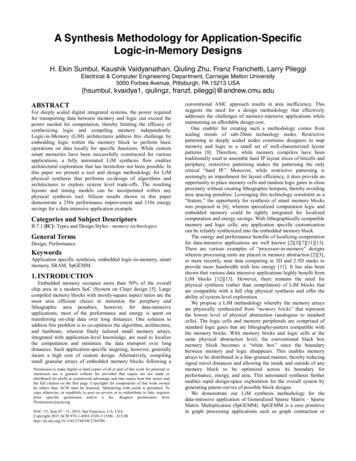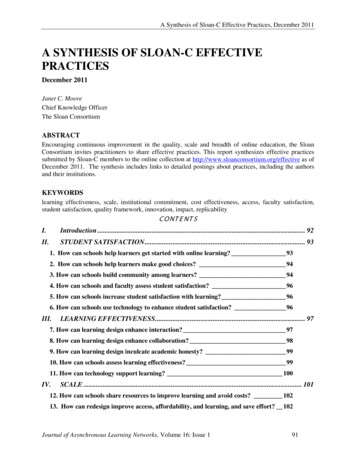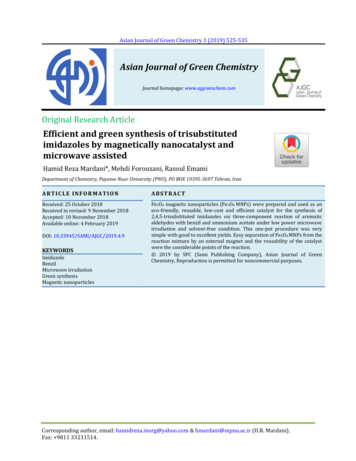
Transcription
Asian Journal of Green Chemistry 3 (2019) 525-535Asian Journal of Green ChemistryJournal homepage: www.ajgreenchem.comOriginal Research ArticleEfficient and green synthesis of trisubstitutedimidazoles by magnetically nanocatalyst andmicrowave assistedHamid Reza Mardani*, Mehdi Forouzani, Rasoul EmamiDepartment of Chemistry, Payame Noor University (PNU), PO BOX 19395-3697 Tehran, IranARTICLE INFORMATIONABSTRACTReceived: 25 October 2018Received in revised: 9 November 2018Accepted: 10 November 2018Available online: 4 February 2019Fe3O4 magnetic nanoparticles (Fe3O4 MNPs) were prepared and used as aneco-friendly, reusable, low-cost and efficient catalyst for the synthesis of2,4,5-trisubstituted imidazoles via three-component reaction of aromaticaldehydes with benzil and ammonium acetate under low power microwaveirradiation and solvent-free condition. This one-pot procedure was verysimple with good to excellent yields. Easy separation of Fe3O4 MNPs from thereaction mixture by an external magnet and the reusability of the catalystwere the considerable points of the reaction. 2019 by SPC (Sami Publishing Company), Asian Journal of GreenChemistry, Reproduction is permitted for noncommercial purposes.DOI: Microwave irradiationGreen synthesisMagnetic nanoparticlesCorresponding author, email: hamidreza.inorg@yahoo.com & hmardani@mpnu.ac.ir (H.R. Mardani).Fax: 9811 33211514.
Efficient and green synthesis of trisubstituted 526Graphical AbstractIntroductionMulti-substituted imidazoles are an important class of heterocyclic compounds with widebiological and pharmaceutical applications [1‒3]. The substituted imidazoles are well known asinhibitors of P38 MAP kinase [4] and therapeutic agents [5]. Imidazoles chemistry, because of its usein ionic liquids [6] and in N-heterocyclic carbenes (NHCs) [7], gave a new dimension in the area oforganometallics and ‘‘green chemistry’’. Other important features of these compounds are including,anti-inflammatory [8], anti-parasitic [9], antifungal [10], antidepressant [11], anti tubercular [12],anticancer [13] and antiviral activities [14], and anti leishmanial activity against the leishmaniadonovani [15].There are many methods available in the literature which describe reliable synthesis of 2,4,5trisubstituted imidazoles via three-component condensation of aldehydes, benzyl and ammoniumacetate at the presence of various catalytic species, such as acetic acid [16], silica sulfuric acid [17], I2[18], (Zr(acac)4) [19], L-proline [20], montmorillonite K10 [21], Cu(NO3)2–zeolite [22], ionic liquids[23‒25], DABCO [26], urea-functionalized Fe3O4/SiO2 [27] and Fe3O4@SiO2.HM.SO3H under
H.R. Mardani et al.527microwave irradiation at 450 W [28]. Despite the efficiency of the reported protocols, some of themsuffer from some drawbacks such as long reaction time, harsh reaction conditions, corrosiveness,toxicity, cost, and reusability of catalyst.In recent years, Fe3O4 MNPs have attracted a great attention in many different fields due to theirintrinsic properties including, high surface area, low toxicity, super-paramagnetic behavior, and easyseparation and recovery from the reaction medium by magnetic decantation [27‒29]. In other words,the use of microwave for the synthesis of organic compounds under solvent-free condition hasproved to be efficient, safe and environmentally benign technique, with shorter reaction time, highyields, and easier work-up [23, 30‒32]. However, incorporation of the cyclo condensation pathwaywith MW irradiation and property of Fe3O4 MNPs causes imidazoles be achieved in higher yields andshorter time. Therefore, in this research study, we introduced the Fe3O4 MNPs as a greenheterogeneous catalyst for the synthesis of 2,4,5-trisubstituted imidazoles via the three-componentreaction of various aromatic aldehydes with ammonium acetate and benzil under solvent-freecondition and low power microwave irradiation (Scheme 1).ExperimentalMaterials and MethodsChemical materials were purchased from Merck and aldrich chemical companies in high purity.Microwave irradiation was carried out by a kenwood microwave oven with power output of 1000 W.The progress of the reactions and purity of the products were monitored by TLC (thin layerchromatography). The melting points were determined using the electro-thermal-IA9200 meltingpoint apparatus. Fourier transform infrared spectroscopy (FT-IR) was recorded on a PERKIN-ELMERRXI spectrometer using KBr pressed powder discs. The NMR spectra were measured in puredeuteriated dimethyl sulfoxide (DMSO-d6) as solvent on a Bruker avance 400 MHz instrument (1HNMR 400 MHz) with tetramethylsilane (TMS) as the internal reference. The XRD data of thesynthesized nanoparticle was obtained with a Bruker x-ray diffractometer (Advanced-D8) using CuKα radiation.Preparation of nano catalystSynthesis of the Fe3O4 nanoparticles was carried out using a modified procedure [33]. A typicalprocedure, 5.2 g of FeCl3 and 2.0 g of FeCl2 were successively dissolved in 25 mL of double-distilledwater containing 0.85 mL of 12.1 N HCl. The resulting solution was then added dropwise into 250 mLof 1.5 M NaOH solution under vigorous stirring. The last step generated an instant black precipitate.
Efficient and green synthesis of trisubstituted 528The precipitate was isolated in the magnetic field, and the supernatant was removed from theprecipitate by decantation.General procedure for synthesis of 2,4,5-trisubstitutedimidazolesThe aromatic aldehyde (1 mmol), benzils (1 mmol), NH4OAc (5 mmol, 0.385 g) and catalyst (Fe3O4,0.05 gr) were mixed thoroughly in a glass vessel. The reaction mixture was irradiated in a domesticmicrowave oven at 200 W for appropriate time. After completion of the reaction, as monitored withTLC, the reaction mixture was cooled at room temperature. Then, 10 mL acetone was added intocrude reaction mixture and the catalyst was separated using an external magnet. The products wereobtained by the addition of 10 mL cold water to the acetone solution. Further purification by columnchromatography and recrystallization gave the desired products. The products were characterizedon the basis of their melting point, IR, 1H, and13CNMR spectra. It was found that the recoveredcatalyst could be used directly for five cycles without noticeable drop in the catalytic activity.2,4,5-Triphenyl-1H-imidazolemp 273 275 C, IR (KBr) (νmax/ cm-1): 3434, 2993, 2470, 1638, and 1216. 1H NMR (CDCl3/DMSO-d6):δ 12.61 (1H, brs), 7.42-8.12 (15H, m). 13C NMR (CDCl3/DMSO-d6): δ 136.5, 129.1, 128.5, 127.2, 122.1.Anal. Calcd. for C12H16N2: C, 85.11; H, 5.44; N, 9.45; Found: C, 85.02; H, 5.1; N, emp 227 229 C, IR (KBr) (νmax/ cm-1): 3428, 2893, 2465, 1636, and 1216. 1H NMR (CDCl3/DMSO-d6):δ 3.85 (s, 3H), 12.52 (1H, brs), 8.02-8.05 (2H, d), 7.25-7.59 (10H, m), 6.93-6.96 (2H, d), 3.85 (3H, s).13CNMR (CDCl3/DMSO-d6): δ 159.1, 145.7, 132.8, 127.6, 126.5, 126.3, 122.7, 113.2, 54.6. Anal. Calcd.for C22H18N2O: C, 80.96; H, 5.56; N, 8.58; Found: C, 80.68; H, 5.23; N, p 259 262 C, IR (KBr) (νmax/ cm-1): 3447, 1620, and 1519. 1H NMR (CDCl3/DMSO-d6): δ 12.71 (br,s, 1H), 7.76-7.89 (d, 2H), 7.44-7.51 (d, 2H), 7.10-7.41 (m, 10H). 13C NMR (CDCl3/DMSO-d6): δ 124.9,Scheme 1. Synthesis of trisubstitutedimidazoles using Fe3O4 MNPs under solvent-free andmicrowave irradiation conditions.
H.R. Mardani et al.529126.3, 126.8, 128.1, 129.2, 129.9, 132.3, 143.9. Anal. Calcd. for C21H16N2: C, 76.25; 76.14; H, 4.53; 4.55;N, 8.47; Found: C, 76.14; H, 4.55; N, 8.37.2-(4-Bromophenyl)-4,5-diphenyl-1H-imidazolemp 263 265 C, IR (KBr) (νmax/ cm-1): 3450, 3070, 1615, and 1320. 1H NMR (400 MHz, DMSO-d6): δ12.68 (s, 1H), 8.15 (d, 2H), 7.50–7.13 (m, 12H). 13C NMR (400 MHz, DMSO-d6): 146.1, 130.5, 129.6,129.1, 128.4, 127.2, 127.0, 126.6, 125.5, 125.1, 123.0, 116.2. Anal. Calcd. for C21H15BrN2: C, 67.21; H,4.03; N, 7.47; Found: C, 67.06; H, 3.71; N, 7.21.Results and DiscussionFe3O4 MNPs were synthesized according to the reported procedures in the literature [28]. Thenano catalyst structure was characterized using FT-IR, SEM, and EDX [36]. For Fe3O4 nanoparticles,the broad peak observed at 584 cm-1 and 765 cm-1 should be attributed to the Fe‒O stretchingabsorption, the peaks at 1637 and 3432 cm-1 are attributed to the O‒H of H2O, similar to the literature.The XRD pattern of the prepared Fe3O4 nanomaterial was similar to the references information oflibrary data. It has got 9 line, the position and relative intensities of the peaks are compatible withthe cubic crystals. The average crystallite sizes of Fe3O4 was found to be 18.5 nm. The EDX spectrumis demonstrated Fe and O elements in sample. The FESEM image showed a tiny spherical mushroommorphology for Fe3O4 (Figure 1).In the next step, to assess the catalytic activity of Fe3O4 MNPs in the synthesis of 2,4,5trisubstituted imidazoles, the three component condensation of P-hydroxybenzaldehyde 1b (1mmol) with NH4OAc 2 (5 mmol) and benzil 3a (1 mmol) was investigated as a model reaction underdifferent conditions, and the results are summarized in Table 1. It was observed that, when the modelreaction was carried out in the absence of any catalyst under solvent-free condition and microwaveirradiation at 200 W, no desired product was formed after 10 min (Table 1, entry 1).Countsfe3o4300200100020304050Position [ 2Theta] (Copper (Cu))6070
Efficient and green synthesis of trisubstituted 530Figure 1. The FT-IR spectrum, XRD pattern, EDX and FESEM image of the Fe3O4Table 1. Optimization of reaction conditions for the synthesis of 2-(P-hydroxyphenyl)-4,5-diphenylimidazole 4baEntry1Catalyst (g)-Solvent-Power(w)200Time (min)10Yield (%)a-2SiO2 (0.2)-40010trace3BaCl2 (0.2)-40010604Na2SO4 (0.1)-40010225Fe3O4 (0.05)-20010956Fe3O4 (0.01)-20010207Fe3O4 (0.1)-20010978Fe3O4 (0.05)-10010759Fe3O4 (0.05)-400109510Fe3O4 (0.05)H2O200105011Fe3O4 (0.05)CH3CO2H200106012Fe3O4 (0.05)EtOH200105013Fe3O4 (0.05)THF200107014Fe3O4 (0.05)CH2Cl2200105015Fe3O4 (0.05)Et2O2001050Yields refer to isolated products
H.R. Mardani et al.531Table 2. Fe3O4 MNPs catalyzed synthesis of 2,4,5-trisubstituted imidazoles under solvent-free andmicrowave irradiation conditionsaEntry1RHXH2Hp-OH3H4Time(min)20MP (oC)/observe273-275MP (oC)/report272-273 [18]9510265-266268-270 [34]p-Cl8725259-261262-264 2636Hm-NO29010313-315308-309 0217-219-10Ho-Cl8725195-196195-196a TheYield (%)b85reaction condition: benzil (1 mmol), aldehyde (1 mmol), ammonium acetate salt (5 mmol), solvent-free,microwave irradiated at 200 Wb Yieldsof the isolated productTo explore the suitable reaction conditions, the above model reaction was performed at thepresence of various catalysts such as nano SiO2, BaCl2, Na2SO4 and Fe3O4 MNPs under solvent-freeand microwave irradiation conditions (Table 1, entries 2-5). The Fe3O4 MNPs demonstrated superiorcatalytic activity among those examined (Table 1, entry 5). To investigate the effect of solvent, thecondensation reaction of the model substrates was carried out in different solvents including CH2Cl2,Et2O, THF, EtOH and H2O using 0.05 g Fe3O4 MNPs under the microwave irradiation conditions (Table1, entries 10-15). Screening the solvent in this reaction revealed that the under solvent-freeconditions, highest yield of the desired product is obtained as compared to the tested solvents (Table1, entry 5).We also evaluated the amount of catalyst required for this transformation. The amount of Fe3O4MNPs, which afforded the best yields, was 0.05 g. Increasing the amount of catalyst did not changethe yield dramatically (Table 1, entry 7), whereas reduction of it significantly decreased the product
Efficient and green synthesis of trisubstituted 532yield (Table 1, entry 6). Then the reaction was studied at the presence of different molar ratios ofNH4OAc (1-8 mmol) as an ammonia source, and the best result was obtained with 5 mmol of NH4OAc.Power of the microwave instrument was also optimized and the best operating power was found tobe 200 W.To explore the generality and applicability of this catalyst a variety of aromatic aldehydes reactedwith benzils and ammonium acetate under the optimal reaction conditions and the results arepresented in Table 2. Aromatic aldehydes substituted with either electron-donating orelectron-withdrawing groups underwent the reaction smoothly and in all cases the desired productwas synthesized in high yield. As seen in Table 2, when 4,4ꞌ-dimethoxybenzil 3c was used instead ofbenzyl 3a, the reaction time was increased (Table 2, entries 8 and 9). The structure of products 4a–jwas characterized on the basis of their 1H and 13C NMR, IR and mass spectroscopic data.To evaluate the recyclability and stability of the catalyst, we designed a set of experiments byconducting successive condensation of model substrates using the recovered Fe3O4 MNPs under byapplying the optimized conditions. After the completion of the first reaction run, acetone was addedto the reaction mixture and catalyst was easily removed by an external magnet and recovered simplyby washing with EtOH, and vacuum drying, and then reused for at least 4 times without observationnoticeable drop in activity (Figure 2).The proposed mechanism for the synthesis of trisubstituted imidazoles 4 can be described asshown in Scheme 2 [20‒35]. Fe3O4 MNPs act as Lewis acid and play a significant role in increasingthe electrophilic character of the aldehyde. Subsequently, the reaction of the activated aldehyde withtwo molecules of ammonia to afford diamine intermediate 5, which condenses with the carbonylcarbons of the benzyl at the presence of Fe3O4 MNPs followed by dehydration to form the iminointermediate 6, which rearranged to the desired trisubstituted imidazole 4.ConclusionIn this study, we have confirmed a simple method f
Benzil Microwave irradiation Green synthesis Magnetic nanoparticles . Efficient and green synthesis of trisubstituted 526 Graphical Abstract Introduction Multi-substituted imidazoles are an important class of heterocyclic compounds with wide biological and pharmaceutical applications [1‒3]. The substituted imidazoles are well known as inhibitors of P38 MAP kinase [4] and therapeutic .

